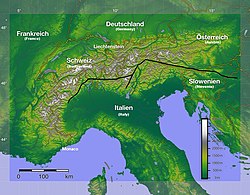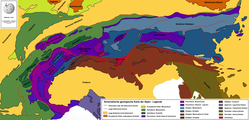Periadriatic suture
Below: From the simplified map of the tectonic Alps shows how at the seam Periadriatic Penninic ( ) and Eastern Alps ( ) from Southern Alps ( are delimited).
The periadriatic seam (also periadriatic lineament , alpine-dinaric boundary fault or alpine-dinaric scar ) is the most important tectonic fault line in the Alps with a total length of 700 km . Its name comes from the fact that it runs in a wide arc roughly parallel to the coastline of the Adriatic Sea . However, it runs through a much larger part of the Alps. Almost M-shaped, it extends between Turin in the west and Slovenia or southern Hungary in the east and separates the southern Alps from the ceiling system of the northern Alpine arc.
Emergence
The clods shifted along this fault line both horizontally and vertically. In some places , the Eastern Alpine nappes have been raised by several kilometers compared to the Southern Alps, with the result that the crystalline surface came to the surface to the north , while sedimentites predominate to the south of the line , which remained largely unaffected by the tectonic events and metamorphoses affecting the Eastern and Western Alps recorded towards the end of the Middle Ages (approx. 100 million years ago). It is assumed that the Southern Alps have shifted about 50 to 100 km to the west compared to the original area of origin.
nature
The periadriatic seam is an old lineament that existed long before the Alpid mountain formation. Indications for this are u. a. Variscan rock formations, sediment wedges of the Permotrias and protruding deep rock ( granite , tonalite ), which are called periadriatic or periadriatic intrusiva in geology . In their area, especially south of the Tauern window, a noticeable piece of the ancient Alpine crust is missing. According to R. Oberhauser (1980), this is also where the lost root zone of the Northern Limestone Alps can be located.
course
Large longitudinal valleys morphologically indicate the course of the periadriatic lineament over long sections . It appears north-west of Turin as an insubric line under the young tertiary and quaternary deposits of the Po Valley and extends just north of the northern Italian lakes into the Valtellina . From Sondrio it continues as the Tonale line over the Aprica Pass and over the upper Camonica Valley to the Tonale Pass and on to Dimaro in the Sulztal ( Val di Sole ). At Dimaro's, it meets the Judiciary line at an acute angle , which runs straight in from Lake Idro over Madonna di Campiglio . The main fault line continues over Malè and Proveis and then over the Hofmahdjoch and through the valley to the outer Marauner Ultental towards Meran . There it follows the Naiftal into the upper Penser Valley and crosses the Penser Joch to Mauls .
From there it follows the distinctive longitudinal valley as the Pustertal line , which separates the limestone of the Dolomites from the old crystalline rocks and tertiary tonalites of the Eastern Alps adjoining to the north . It borders the Brixner granite in the north and runs over the village of Vals to the Stollbergsattel to Terenten and Kiens , until the Brixner granite is submerged about 2 km east of Kiens. The disturbance moves via Bruneck on the north side of the main valley to the Drautal near Sillian . This is where the section called the Gailtal Line begins , which is followed by the Karawanken Line , which divides the mountain range into North and South Karawanken and can be followed up to the eastern edge of the Alps and the Bacher Mountains . To the east of it, it dips under the tertiary and quaternary deposits of the Pannonian Basin and ends. Before that, not far from the border triangle Austria-Italy-Slovenia, the Sava Line branches off to the southeast and south.
Overview:
- Biella - Insubric Line - Valtellina
- Tonale Line ( Valcamonica - Tonale Pass - Val di Sole )
- northern judiciary line
- Meran
- Gail-Pustertal line ( Bruneck - Pustertal - Gailtal )
- Drau Line ( Rosental - Karawanken)
See also
Individual evidence
- ↑ Bögel Helmuth, Schmidt Klaus: Small geology of the Eastern Alps. Otto Verlag, Thun 1976
- ↑ Rudolf Oberhauser (ed.): The geological structure of Austria . Springer-Verlag and GBA Vienna, 1980.
Web links
- Periadriatic lineament: interface between the northern and southern Alps , Rocky Austria, Geological Federal Institute Vienna.

